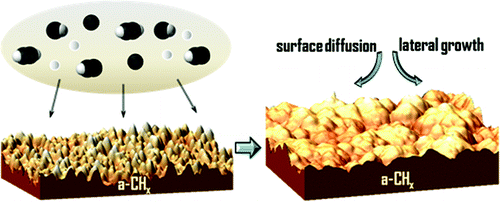C. López-Santos, J.L. Colaux, J.C. González, S. Lucas
Journal of Physical Chemistry C, 116 (2012) 12017–12026
doi: 10.1021/jp300697s

The study of the growth mechanisms of amorphous hydrogenated carbon coatings (a-CHx) deposited by reactive pulsed magnetron discharge in Ar + C2H2, Ar + H2, and Ar + C2H2 + H2 low-pressure atmospheres is presented in this work. Hydrogen-containing species of the reactant gas affect the microstructure and surface properties of the a-CHx thin films. The dynamic scaling theory has been used to relate the main reactive species involved in the deposition process to the growth mechanisms of the thin film by means of the analysis of the roughness evolution. Anomalous scaling effects have been observed in smooth a-CHx coatings. Dynamic scaling exponents α, β, and z indicate a general growth controlled by surface diffusion mechanisms. Hydrogen species have an influence on the lateral growth of the a-CHx coatings and are involved in the development of a polymeric-like structure. Meanwhile, hydrocarbon species promote the generation of higher aggregates, which increases the roughness of a more sp2 clustering structure of the a-CHx coating.

